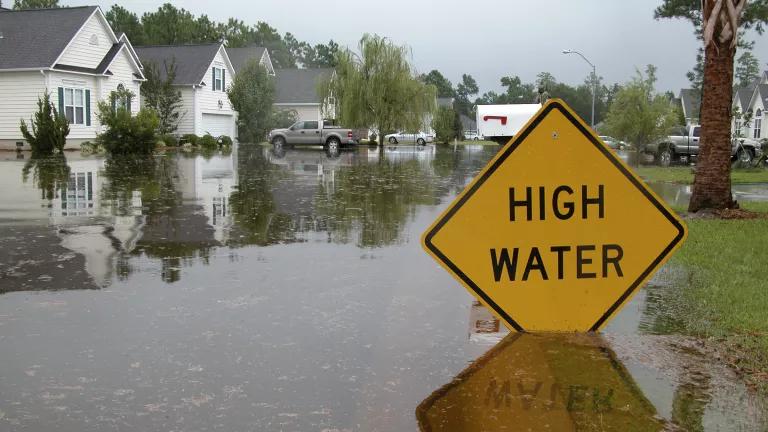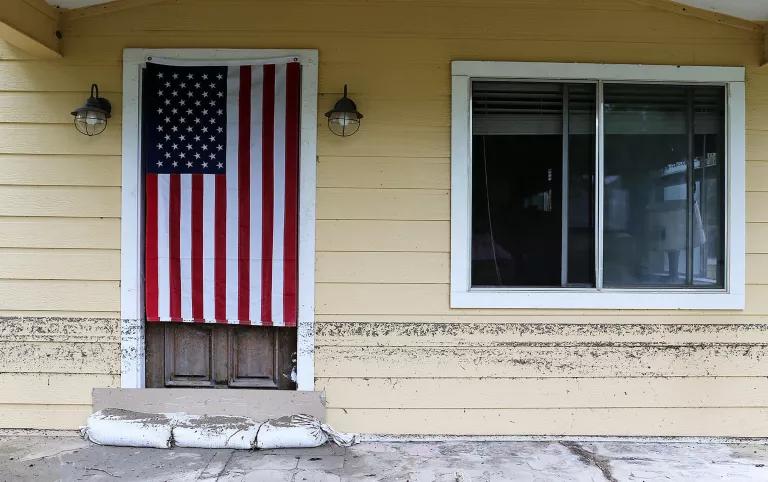It’s Time to Fix Our Water-Logged National Flood Insurance Program
The NFIP has made strides in reducing risk and promoting equity. But it’s still in hot water.

For a nation facing rising sea levels and more frequent severe storms due to the climate crisis, our National Flood Insurance Program (NFIP) is woefully inadequate, despite it being the nation’s primary mechanism for addressing flood risk. In recent years, in fact, the NFIP has actually—if unintentionally—failed to discourage people from moving to flood-prone areas, and has carried out policies that end up benefiting whiter, wealthier communities.
“The NFIP is outdated and ill prepared for the impacts of climate change,” says Joel Scata, an attorney in NRDC’S Healthy People & Thriving Communities program. “The program must be reauthorized and reformed to ensure that the nation’s communities are prepared.”
Here’s the rundown of why the NFIP is so badly needed in the first place, how it got into this mess, what steps it’s taking to right itself, and what will still need fixing as the country heads into a warmer (and often wetter) future.
Flood risk in the climate era
It’s an indisputable fact: Warming seas and shifting precipitation patterns are causing more severe floods to happen more frequently. For people who live along coastlines, rivers, or other waterways, this is a very real threat. Storm surges have the power to destroy homes and upend lives. And for people who live in urban areas, even those far away from rivers or oceans, flooding from overburdened storm sewer systems is also disastrous.
According to the Federal Emergency Management Agency (FEMA), which manages the NFIP, areas with a high risk of flooding will increase by 55 percent along the eastern coast, and 45 percent along its major rivers, by 2100. One recent study predicts that the number of U.S. homes at substantial risk of experiencing a 100-year flood—which means that such a severe weather disaster has a 1 percent chance of occurring in any given year—will rise from around 14.6 million today to at least 16.2 million (and quite possibly more) by 2050.
Despite all this, prospective homeowners continue to stream to coastal and riverside areas, which effectively raises the value of those properties at risk of floods. In the coming decades, an estimated 4 million to 13 million more people will be living in flood-prone homes along the nation’s coasts—and that’s not even counting the growing number of people at risk along our inland waterways. FEMA expects the number of residents required to buy NFIP insurance along the coasts to increase by as much as 130 percent by the end of the century.

What the NFIP got right—and where the NFIP went wrong
When the NFIP launched back in 1968, it represented a major step forward for people affected by flooding. Private insurers at the time generally balked at underwriting flood risk, so the federal government stepped in. By offering government-backed flood insurance policies—and eventually requiring owners of homes in floodplains to buy in—the program streamlined the flood recovery process. Through its insurance premiums, homeowners began contributing to the cost of rebuilding; in return, assistance became immediately available in the aftermath of a flood for those who purchased coverage.
Through the NFIP, FEMA also assumed responsibility for mapping flood risk, which helps inform communities about which low-lying areas are most likely to see flooding. The agency required communities to adopt building and zoning ordinances using established standards for development that would theoretically help structures survive a flood. If communities wanted their residents to be able to purchase flood insurance, they needed to adopt these standards, along with the flood maps, to guide future development decisions.
But there was never any consideration of how flood risk might change in the future. And in all aspects of the program, there was the assumption that the future would look identical to the past. The building and land-use standards that communities must adopt in order for residents to purchase NFIP insurance haven’t been comprehensively updated since the 1970s. These outdated codes, established decades before climate change was a household term, “are failing to keep our nation’s communities safe, and will continue to do so as climate change makes flooding more common,” Scata says.
In 2021, NRDC and the Association of State Floodplain Managers jointly petitioned FEMA to update its standards in order to reflect the new climate reality. Among the petition’s requests were that all new or substantially improved structures be elevated higher than the level of a 100-year flood; that all new and revised NFIP floodplain maps depict how the floodplain will change over time, especially concerning sea level rise; and that homeowners seeking to retrofit their homes have easier access to NFIP funding.
Pricing flood risk—past and present
Historically, the NFIP heavily subsidized the premiums for some of the most flood-prone homes. This had the unintentional effect of masking the true risk faced by homeowners, since the price of premiums wasn’t accurately reflecting the chances of a particular home flooding and requiring a payout. What’s more, floodplain maps and other data-collection formats used by the NFIP to identify at-risk properties tended to make few, if any, distinctions between homes based on their physical siting (e.g., next to a river versus a mile away from one) or their construction materials (e.g., masonry versus wood). By decoupling the cost of premiums from the likelihood of risk, the program has actually ended up encouraging—rather than discouraging—the placement of homes in high-risk areas over the years. And by painting so many homes with the same broad actuarial brush, it has effectively built inequity into the system.
Today, NFIP covers more than five million policyholders in 23,000 communities across the country, providing nearly $1.3 trillion in coverage. But the structural problems that have beset the program for decades—and which have only been exacerbated by climate change—have finally brought the NFIP to a crossroads. To its credit, the program has decided to make some real, substantive changes to the way it calculates flood risk and interprets and shares flood-related data. If implemented properly, the NFIP’s new approach, which it has named Risk Rating 2.0, should go some way toward redressing many of the program’s imbalances.
One of the biggest changes: Flood insurance will now be priced according to each home’s unique and property-specific characteristics—including its elevation, its proximity to water, and its total cost to rebuild—and not simply its location on a floodplain map. FEMA is also upping its technology and data-collection game, incorporating the latest developments in catastrophe modeling and actuarial science. By improving its ability to predict when, where, and how a flooding event could impact not only a community but the individual homes within it, FEMA aims to make the NFIP more equitable and to strengthen the mitigation aspect of its larger mission.

After decades of being presented with a woefully distorted picture of the risk they faced, policyholders will now have a much clearer understanding of their vulnerability and how to lessen it. And by updating floodplain maps and pairing premiums to a home’s specific characteristics, the NFIP hopes to put an end to a system that has frequently benefitted well-off risk-takers at the expense of the economically disadvantaged or the risk-averse.
Risk Rating 2.0 “should make flood insurance more fair” in general, says Scata. “No longer will expensive beachfront houses be subsidized by lower-cost, less-risky homes.” And about 20 percent of policyholders will pay less under the new system. However, he notes, the cost of insurance for homeowners is still out of reach for too many. “Increasing prices means that some of the people who may need flood insurance the most can’t afford it,” he says. “Congress must act to create a means-tested flood insurance option that helps lower-income families purchase flood insurance, and that prioritizes those same families for flood adaptation assistance.”
And, Scata adds, “FEMA must act quickly to ensure these standards are capable of handling the floods of today and those of the future. Because climate change won’t wait.”
How to prepare your home for a flood
Here are some steps you can take if you’re concerned about your home’s flood risk.
- Start by visiting floodsmart.gov, the NFIP’s website, for information on flood maps, the costs of flooding, and how to obtain flood insurance.
- Make a plan. The difference between being prepared and being unprepared for a flood is often the difference between losing a few things and losing everything.
- Buy insurance. Despite the NFIP’s lingering problems, it’s still a good idea to buy flood insurance if your home is at risk. Anyone with a federally backed mortgage who lives within a high-risk flood zone is required by law to carry it—but even if you live outside of one, or if you rent your home, it’s worth investigating the benefits of purchasing a policy relative to your home’s unique risk. People who live outside of mapped high-risk flood zones make up more than 20 percent of all flood insurance claims. When possible, homeowners should also get insurance for storm drain backups that may flood their basements (for which the NFIP only offers very limited, restricted coverage), and renters can buy flood insurance that will cover the personal items in their rental space.
- Elevate any utilities—boilers, central air-conditioning units, and other HVAC equipment—that are located at the lowest level of your home and that are particularly vulnerable to flood damage. Moving them to a platform even just a few feet higher off of the ground can often spare them from malfunction—or destruction—in the event of a flood.
- Consider installing a sewage water backstop—sometimes called a sewer backwater preventer or a sewer backwater valve—to keep overtaxed sewer mains from backing up into your basement.
- Understand the different options for addressing risk—and speak up for change in your community.
This story was originally published on July 13, 2017, and has been updated with new information and links.
This NRDC.org story is available for online republication by news media outlets or nonprofits under these conditions: The writer(s) must be credited with a byline; you must note prominently that the story was originally published by NRDC.org and link to the original; the story cannot be edited (beyond simple things such as grammar); you can’t resell the story in any form or grant republishing rights to other outlets; you can’t republish our material wholesale or automatically—you need to select stories individually; you can’t republish the photos or graphics on our site without specific permission; you should drop us a note to let us know when you’ve used one of our stories.

Mapping Urban Heat Islands Is Helping These Neighborhoods Adapt
Climate Tipping Points Are Closer Than Once Thought
What Are the Effects of Climate Change?